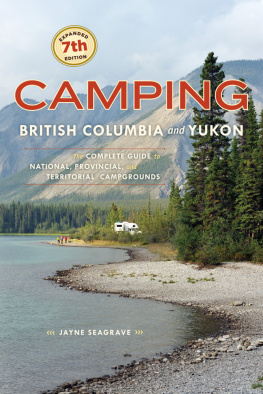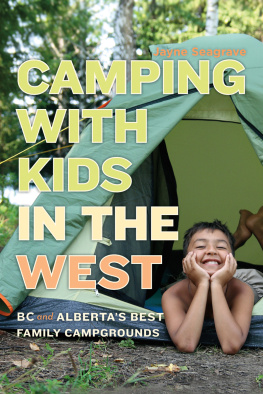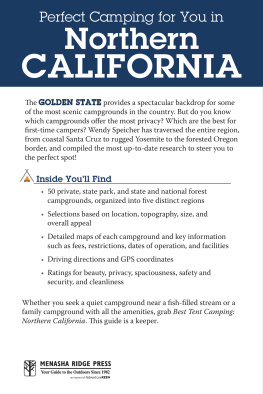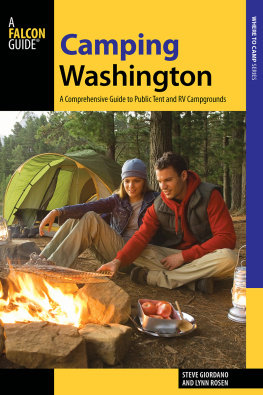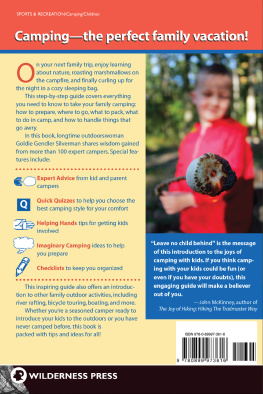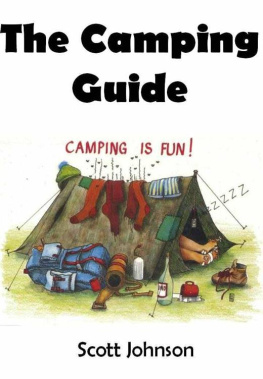Acknowledgements
In 1996, I met nervously with Rodger Touchie, the relatively new owner and publisher of Heritage House Publishing, and suggested a book on camping in British Columbias provincial parks to him. I had moved to BC five years earlier and since that time had been in constant awe of their magnitude, diversity and beauty, and I was amazed that no one had written a guidebook about them. At this time neither Rodger nor I could have envisioned the book would be so well received and become so popular. Each edition of the text is an improvement on the last, and for that I am indebted to Rodger and his colleagues at Heritage House for their knowledge, expertise and guidance. They have all been, and continue to be, a delight to work with. This latest edition also contains many photographs from Trevor Julier, who not only has provided fantastic images but has also been instrumental in informing me about recent developments in the many campgrounds in BC he visits on an annual basis. Trevor has been a great resource and has added considerably to this work.
Information contained in this seventh edition has been gained from personally visiting and camping in almost every BC provincial and national park campground. The latest edition has a brand new chapter on campgrounds in Yukon. Following three separate visits to this territory over the course of the last 10 years, and in recognition of the vast unexplored region few decide to visit, I hope to encourage more visitors to this stunning area of our country. In many respects, writing and researching this new chapter was similar to writing the first edition of Camping British Columbia as the data available on camping in Yukon is very sparse. Fortunately representatives from the Yukon Government Department of Tourism and Culture and the Department of Environment have assisted in providing information, photos and fact checking, which I am very grateful for.
Finally, I have to thank my husband, Andrew Dewberry, who continues to actively encourage me to camp and who has been instrumental in taking many of the photographs for this book, and my two teenage sons, Jack and Sam, for their sincere and continuing joie de vivre and obvious joie de camping.
Jayne Seagrave moved to Canada from England almost 25 years ago. She lives in Vancouver with her husband, Andrew, and their teenage sons, Jack and Sam. She has a Ph.D. in criminology and divides her time between working as the marketing manager for the Vancouver Tool Corporation (vancouvertool.com), the business she owns with her husband, speaking on innovation and the home-improvement industry (jayneseagrave.com) and enjoying her family and the great outdoors.
She is also the author of Camping with Kids: The Best Family Campgrounds in British Columbia and Alberta and From the Mind to the Marketplace: The Story of an Inventor, the Home Improvement Industry, His Wife and Her Lovers and Introduction to Policing in Canada.
CaribooChilcotin Coast
Steeped in the history of the gold rush and covering an area of over 100,000 square kilometres, the Cariboo region has campgrounds situated off Highway 97 north of Cache Creek to Prince George. This section of road is known as the Gold Rush Trail after the pioneers who travelled it in search of the precious metal. Today, many buildings and historical markers recount the days of this original wagon road built in 1860. Campgrounds are also found on minor roads off this major route. The Cariboo is characterized by rolling hills, grasslands, over 8,000 lakes and numerous rivers stretching from the foothills of the Rockies to the Pacic coast. Recently the area has become known for its many guest ranches and for being cowboy country, so go and ride em, cowboy!
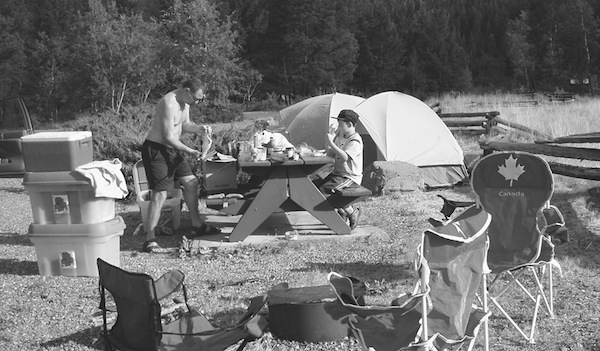
Bull Canyon Provincial Park is between Williams Lake and Bella Coola.
Big Bar Lake
Location
The people who once walked the land around Big Bar Lake were First Nations hunters, cowboys, cattle rustlers and gold prospectors. According to local legends, their ghosts can often be seen and heard, so be attentive when you stay here. Big Bar Lake is on the southern edge of the Fraser Plateau, a landscape formed millions of years ago by debris left by glaciers. Evidence of the ice age can be seen west of the lake, where gravel eskers remain; much of the topography owes its development to this geological period. To reach Big Bar Lake, drive 8 kilometres north of Clinton on Highway 97 and then take a gravel road west for 34 kilometres to the park itself. The nearest services can be found at 70 Mile House.
Facilities
The 332-hectare park has two campgrounds with a total of 46 spots accommodating every size of recreational vehicle. Lakesides 25 sites overlook the lake, and 15 are right on the lakeshore, while the Upper campgrounds larger sites are located in the forest above the lake. The facilities are basic (fire pits, picnic tables, drinking water, pit toilets). Reservations are accepted.
Recreational activities
A naturalists delight, this area is characterized by forests of lodgepole pine and spruce providing an excellent habitat for wildlife, including mule deer, black bears (which we saw while travelling here), cougars, lynx, marmots and snowshoe hares. Easy access to the lake and a boat launch means boating and fishing are possible. The lake is stocked annually with rainbow trout, some rumoured to be as heavy as 3 kilograms. Big Bar Lake is a gorgeous body of water that is also ideal for swimming: crystal-clear water, quite warm and no reeds. Waterskiing is not permitted and there is a speed limit for boats. A 3.5-kilometre trail provides excellent waterfowl and birdwatching, which is facilitated by a water-control structure built by Ducks Unlimited to encourage nesting. Longer hikes are also possible. There is a childrens playground in the day-use area.
Additional information
Big Bar Lake Provincial Park is in an area of rolling hills originally settled by the Salish First Nation. Today, its known as ranch country, and trail rides can be arranged through the numerous guest ranches located in the area. These ranches operate year-round and also offer riding lessons, pack trips, gold-panning excursions and skiing. The fact that snowshoe hares are found around Big Bar Lake should forewarn you that even early in the season, beautiful warm days can turn into clear, cold nights. So act like a cowboy and remember the long johns if youll be camping under canvas. We stayed here in 2006 and I swam at 8:00 p.m. when the entire lake was mine. Bliss. Be warned, though, that mosquitoes affect certain areas of the park, but that problem can be avoided by changing locations.
Bowron Lake
Location
Bowron Lake Provincial Park is famous for its wilderness canoe circuit, which covers over 116 kilometres around 11 different lakes, but theres also a vehicle-accessible campground anyone can use. The park is located 120 kilometres east of Quesnel and 30 kilometres beyond Wells, reached by taking a 27-kilometre dirt road found at the end of Highway 26. Two resorts and some stores on Bowron Lake offer a selection of services, including food and camping supplies, while a full range can be found in Wells.
Facilities
Twenty-ve wooded secluded campsites suitable for vehicles and tents are located near the park entrance and start of the canoe circuit. Facilities are basic (picnic tables, fire pits, drinking water and pit toilets) and reservations are accepted. There are 54 wilderness sites located elsewhere in the 149,207-hectare park for those undertaking the canoe circuit.

